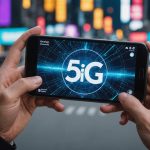Overview of 5G Technology’s Role in Smartphones
5G technology represents a significant leap from its predecessor, 4G, offering unprecedented smartphone capabilities. At its core, 5G technology is designed to provide faster speeds, more reliable connectivity, and reduced latency. This allows for seamless connectivity enhancements, especially in dense urban environments where network demand is high.
One of the critical differences between 4G and 5G networks is bandwidth. 5G technology incorporates wider channels, facilitating higher data transmission rates and supporting a more extensive range of devices simultaneously. This evolution enables cutting-edge applications, such as augmented reality (AR) and virtual reality (VR), on mobile devices, greatly enhancing the user’s interactive experience.
Also to see : Transform Your Tablet into a Daily Reflection Hub: An Innovative Guide to Mastering Digital Journaling
Incorporating 5G impacts smartphone design and specifications, resulting in more power-efficient chips and advanced antennas to accommodate the new frequency bands. These advancements encourage device manufacturers to innovate, leading to sleeker, more sophisticated designs without compromising performance or battery life.
Smartphones optimized for 5G provide users with enhanced download and upload speeds, enabling quicker access to data-heavy apps and media content. As a result, 5G connectivity is ushering in a new era of mobile experiences, improving communication and entertainment while laying the groundwork for future technological developments.
Also to discover : Achieve Seamless Work-Life Balance: Unlock Your Smartphone’s Potential for Effortless Harmony
Performance Metrics Enhanced by 5G
The introduction of 5G technology has revolutionized smartphone performance by significantly amping up speeds and reducing latency. Imagine downloading a movie in just seconds – that’s the speed enhancement 5G delivers. Compared to 4G, where typical download speeds hover around 20 Mbps, 5G can reach speeds of 10 to 20 Gbps, enhancing both download and upload speeds.
Latency improvements further refine the user experience, bringing it to the forefront of mobile technology. While 4G networks experience latency as high as 50 milliseconds, 5G slashes this down to about 1 millisecond. This latency reduction translates to smoother and more responsive interactions during activities like online gaming and video streaming, where lag can drastically impact enjoyment and immersion.
With 5G connectivity, users experience almost instantaneous responses. Streaming services and gaming apps load faster, providing clarity and efficiency that were once unattainable in mobile environments. The combination of speed and latency advancements amalgamates to deliver a smartphone experience that is not only efficient but also more engaging – a leap forward propelling modern mobile technology into a new era of digital possibilities.
Real-World Applications of 5G in Smartphones
5G technology has swiftly transcended from theoretical discussions to real-world examples, dramatically altering smartphone use cases and application performance. Popular 5G smartphones dominate the market, such as those from Apple and Samsung, showcasing seamless integration of this new standard. These devices allow users to witness firsthand the enhanced experiences brought by 5G capabilities.
User testimonials illustrate significant improvements, particularly in gaming and video streaming. Feedback highlights how 5G connectivity resolves previous issues like buffering and lag, leading to a more immersive experience. This is crucial for applications like augmented reality (AR) and virtual reality (VR), which demand high data throughput and low latency.
Emerging applications leveraging 5G also include smart city solutions and telemedicine, which rely on real-time data transfer and analysis. The capacity and speed of 5G facilitate these advanced functionalities, broadening their scope and effectiveness.
Through these real-world examples, it’s evident that smartphone use cases are evolving, making application performance a critical differentiator. The adoption of 5G continues to reshape industries and user expectations, marking a pivotal shift in the way technology and connectivity are utilized daily.
Impact on User Behavior and Expectations
The introduction of 5G technology is reshaping user expectations for mobile apps and services, fundamentally altering how people interact with their devices. With speeds exponentially faster than previous generations, users anticipate instant access to data-rich applications and seamless streaming experiences. This speed also influences user engagement, as consumers are more inclined to spend time on apps that load quickly and operate smoothly.
Latency improvements with 5G play a pivotal role in enhancing user satisfaction. As faster data transfer rates enable virtually real-time interactions, users experience enhanced responsiveness, making applications like mobile gaming and video conferencing more enjoyable and less frustrating.
As a result, consumer expectations have evolved, demanding more sophisticated and efficient smartphone capabilities. For instance, users now expect AR and VR applications to run effortlessly on their phones, without the buffering or delays typical in 4G environments.
With 5G connectivity, content consumption habits are shifting dramatically. Users are streaming more high-definition content and engaging with live streaming platforms, expecting uninterrupted service. These changes highlight the need for service providers to develop innovative solutions that meet the high standards set by 5G, ensuring they remain competitive in this rapidly evolving landscape.
Future Implications of 5G for Mobile Technology
As 5G technology evolves, it paves the way for exciting future trends in mobile technology. Experts predict that smartphones will become even more integral to daily life, with advancements that we can only begin to imagine. The increased capacity and speed of 5G herald an era where smartphones can seamlessly integrate artificial intelligence, enabling intuitive user interactions and advanced functionalities.
In the long term, 5G evolution is expected to inspire groundbreaking innovations in smartphone development. Designers are likely to focus on optimizing energy efficiency and battery longevity, pushing the boundaries of what mobile devices can offer. The refinement of smartphone innovations will allow for more complex applications, creating opportunities for industries to develop niche markets based on these new technological capabilities.
Speculating on future connectivity, there is already talk of what the next generation beyond 5G might entail. While specific details remain theoretical, potential advancements might center around achieving near-instantaneous data transmission, facilitating even more immersive and interactive experiences. The possibilities are vast, and as this technology unfolds, we can anticipate a world more reliant on digital solutions than ever before, fundamentally changing the way we connect and communicate.











